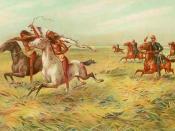Deprived of his land, shunted onto reservations, denied most civil rights, the American Indian, who by 1900 number less than a quarter million, found his rights even on his reservation often ignored or violated. George Kennan, in the spirit of a muckraking journalist, describes in detail one example of outrageous behavior to the Sioux.
Just west of the Missouri River and south of its tributary the Cannonball, partly in North Dakota and partly in South Dakota, was the extensive tract of treeless, dry land known as the Standing Rock Indian Reservation. The land had actually been much bigger in the past. Yet, 3,700 Sioux Indians still lived there comfortably alongside the Missouri River. The Indians were well disposed and obedient to the will of the government. They received government aid and lived fairly easily.
Although they were not deprived of any needs, the American Indians were soon troubled by land hungry Americans.
Americans began to hassle the American Indians to allow them to graze their cattle on the Indians' unused lands. After time, the American Indians allowed the Americans to do so with a charge of one dollar for every cattle head. However, the Americans soon took advantage of the American Indians and began to have thousands of their cattle graze without payment. The hopeless American Indians could not stop the "invasion" and could do nothing but try and keep the Americans away from their homes.
Regarding such wrongs, several questions are brought up about the case. First, the question of whether the Indian Office had any legal right to authorize and order the throwing open of a reservation to foreign cattle without the Indians' consent. Second, the question of whether, having obtained their consent to one form of lease, the commissioner could legally direct the Indian agent...


